This post and the photos within it may contain affiliate links. If you purchase something through the link, I may receive a commission at no extra charge to you.
Welcome back for another tutorial!
This is a beginner’s guide for those looking to learn more about modern calligraphy.
Here is a brief sum-up of what you are going to learn in this tutorial –
- What is modern calligraphy, and how does it differ from traditional calligraphy?
- What tools do you need for modern calligraphy – recommendations.
- How to start with modern calligraphy? Basic strokes
- A few fundamental rules about modern calligraphy to keep in mind.
- FREE downloadable practice sheets.
- Popular modern calligraphy techniques – 3 different styles in order to get you started!
- BONUS – How to effectively practice modern calligraphy.
Without any further delays, let’s begin!
What is modern calligraphy?
Modern calligraphy is any calligraphy style that does not follow the fundamental rules of traditional calligraphy scripts such as Copperplate, Spencerian, Italic, Blackletter, etc. Modern calligraphy relies on certain principles of traditional calligraphy. However, it can provide you with more creative freedom.
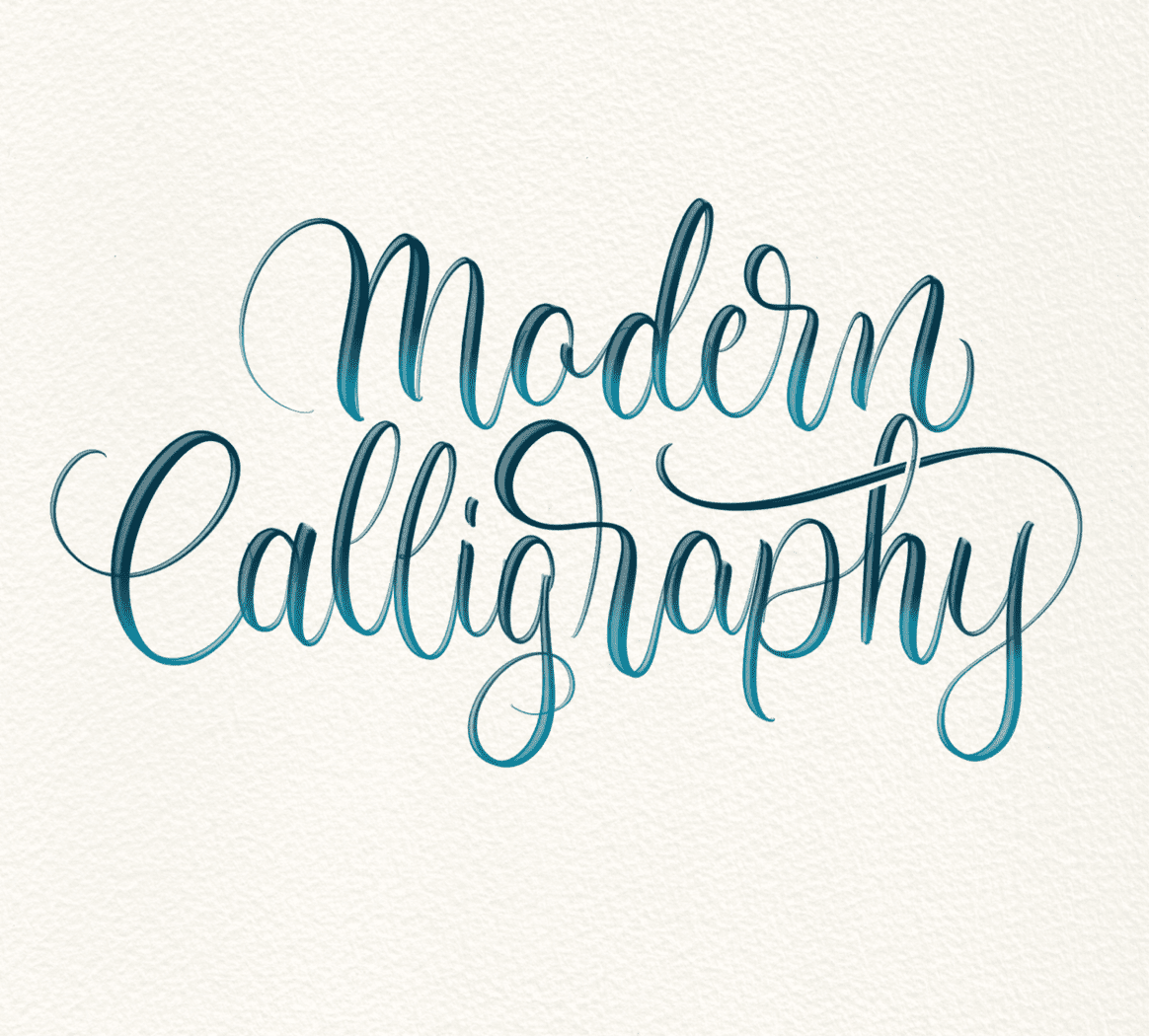
How does modern calligraphy differ from traditional calligraphy?
You see,
Traditional calligraphic scripts (such as the ones mentioned above) are governed by specific, structured, individual strokes that form different letters.
Let’s have a look at some examples.
This is an example of the Copperplate script–
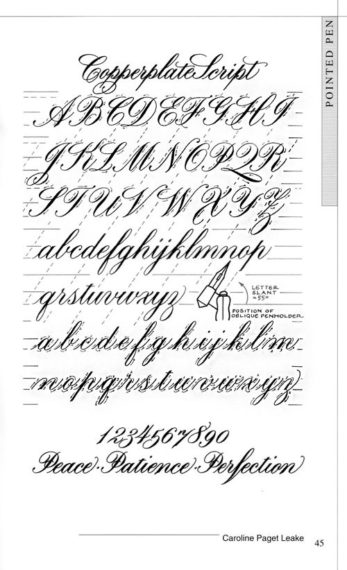
Here is another example of the Spencerian script –
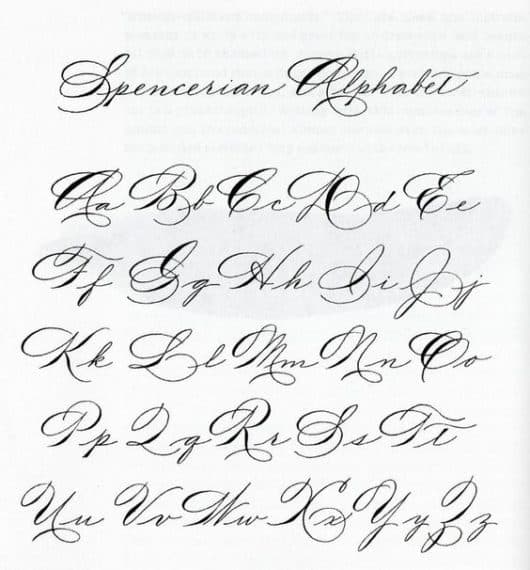
Finally here is another example of a broad-edged script – the Italic hand.
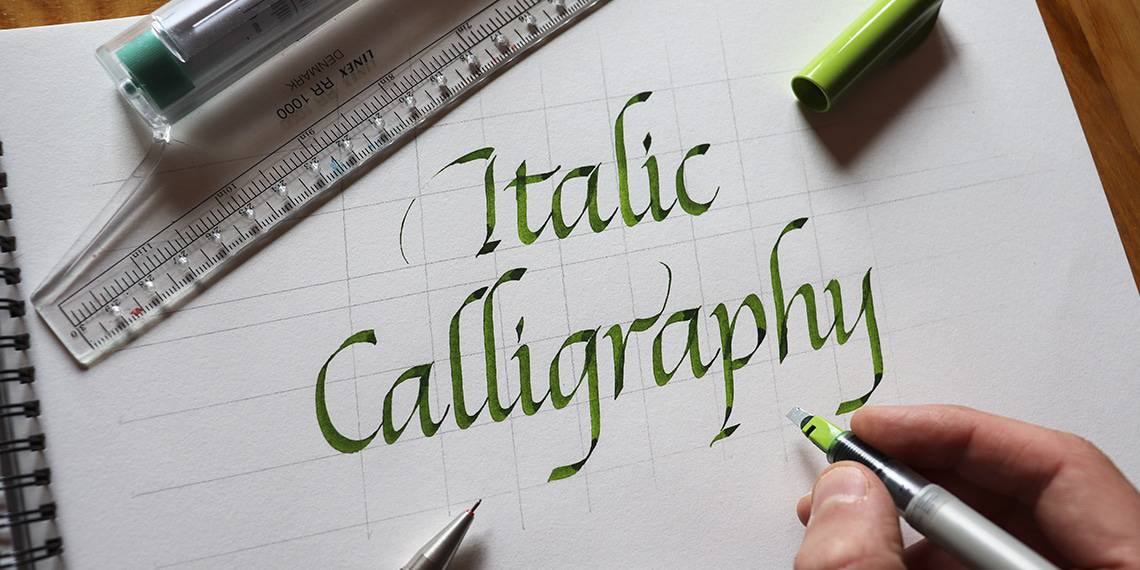
Traditional scripts are done with specific tools and with precise measures of heights and angles.
On the other hand, modern calligraphy has more freedom in its performance.
Don’t get me wrong, you can’t just scribble whatever you want on a piece of paper and call it calligraphy.
There are some basic ground rules that should be applied in order to maintain visual harmony.
These rules may seem complicated and overwhelming, especially for beginners. However, I strongly urge you to stick to them and learn how to practice calligraphy properly from the very beginning.
I will do my best and try to stick to the very essentials in order to make an easier learning experience for you.
Before we jump to these rules, let’s have a quick overview of the tools that we need!

What tools do I need for modern calligraphy?
Now that we know the basic difference between traditional calligraphy and modern calligraphy, it’s time to review some of the essential calligraphy tools that we will need.
Modern calligraphy can be practiced with a whole variety of different tools, such as –
- Brush pens
- Classic dip pens
- Pencil
- Markers
- Broad nib pens (Parallel Pen)
However, if you are a total calligraphy beginner, I would advise you to start practicing calligraphy with either a pencil brush pen simply because it is much easier to learn how to work with compared to the traditional dip pen.
Don’t worry,
I am also going to recommend specific products so you don’t have to waste time looking around for them.
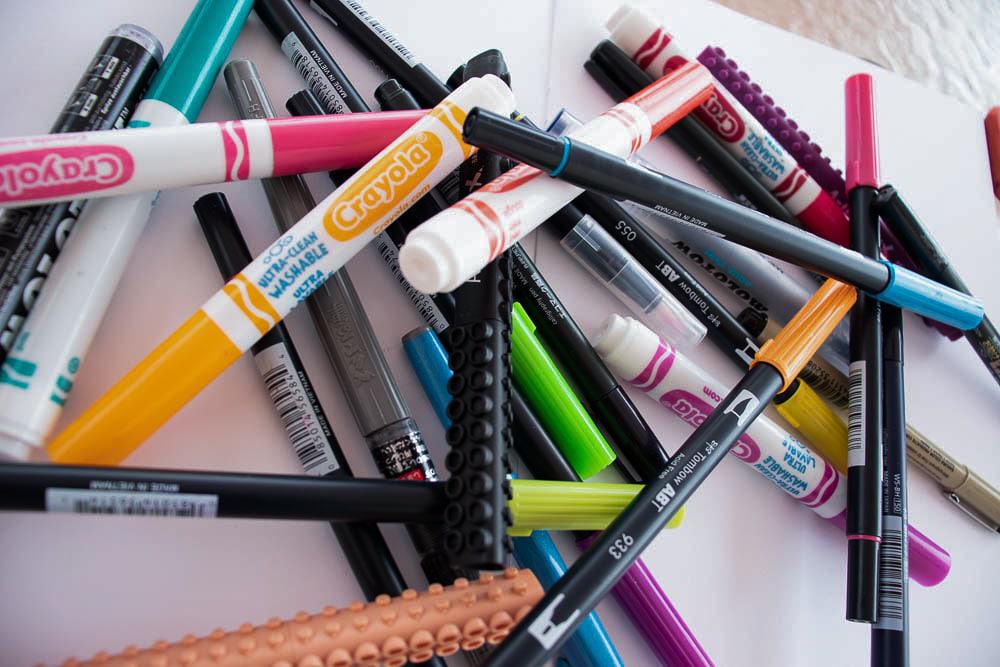
Here is a list of some of the most popular tools for modern calligraphy
1. Brush pens!
As i just mentioned, the brush pens are the easiest tool to start off with.
The reason is that the brush pen has a flexible (felt) nib which allows you to create nice thick and thin lines with ease.
This is essential for calligraphy, and we are going to come to that part right after the tool recommendations.
Here is a recommendation for brush pens –
- Tombow Dual Tip brush pen
- Tombow Fudenosuke
- Crayola Markers
- Ecoline brush pens
- Lyra brush pens
- Artline Stix
- Pentel fude touch sign pen
- Sharpie brush pens
If you want to find out more about the different kinds of brush pens, you can check out this review post.
2. Traditional dip pens
Traditional dip pens consist of two parts –
- The nib
- The holder
The holder can either be a straight holder or an oblique holder (check the image below)
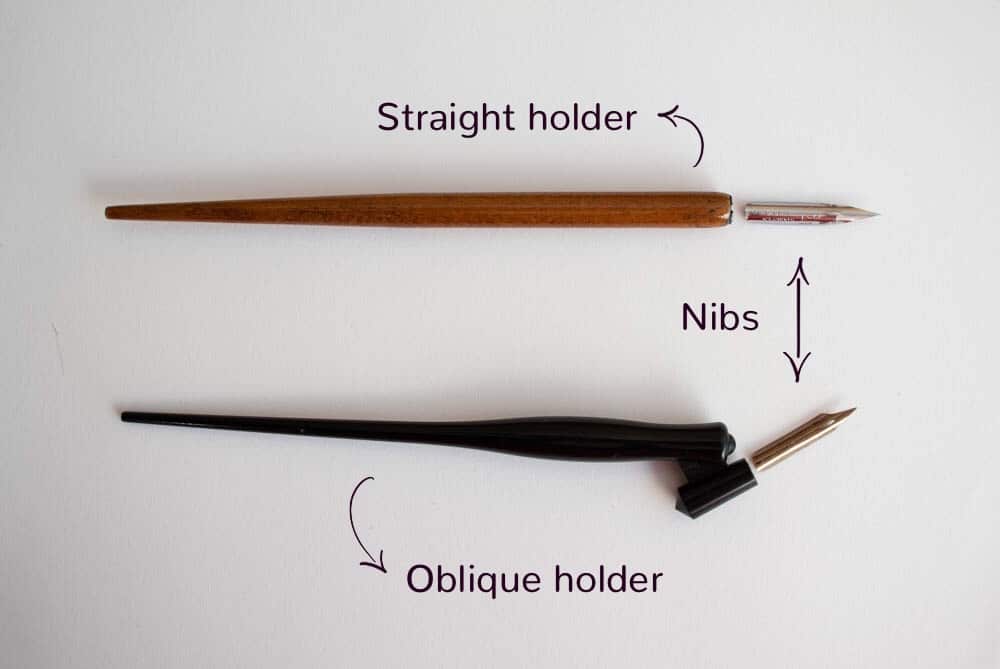
Working with dip pens takes a bit longer to learn, and here is why –
When you work with a dip pen you need to hold it on a specific angle in order for the tines of the nib to open up equally, thus creating a thicker stroke (aka shade).
On top of that, you need to hold it to a certain angle in order to avoid your tip getting stuck in the paper when you create hairlines (thin upstrokes).
We also have a dedicated tutorial on how to get started with dip pen calligraphy if you want to find out more about it.
Essentially you can buy the parts separately but since I constantly see many beginners struggling with this, i would recommend you to take this calligraphy set by Manuscript.
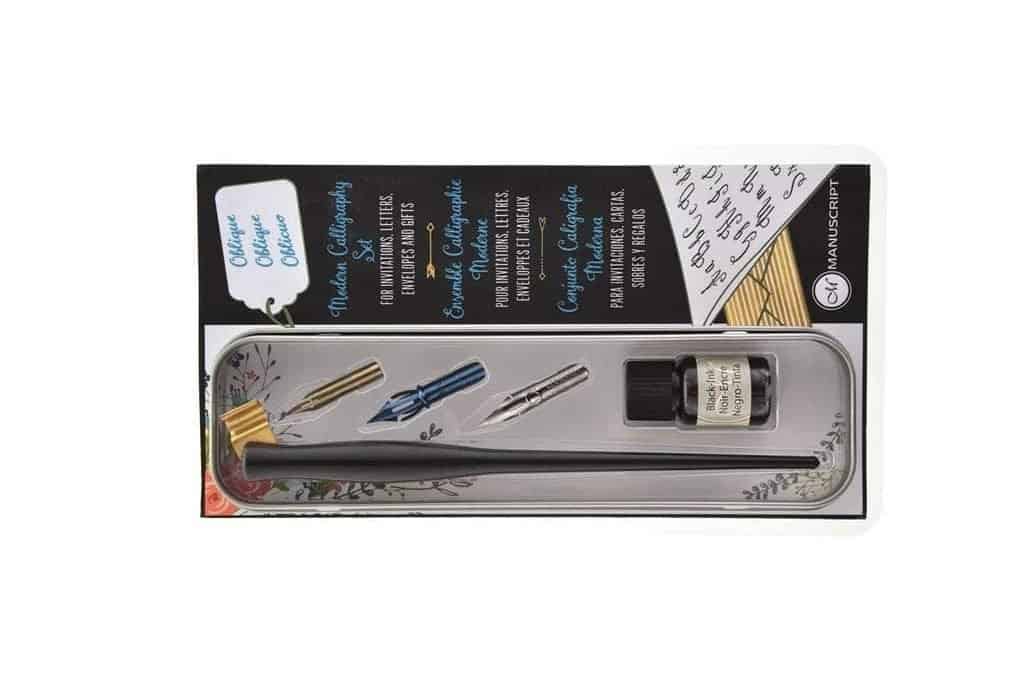
As you can see in the picture above, this set comes with an oblique holder, nibs (with great flexibility), and a bottle of ink.
This is a great set for beginners that gives you everything you need to get started.
Keep in mind that with this tool, you will need to dip your pen in the ink constantly, it will require more maintenance with the nibs, etc.
Taking that into consideration, once again, I would recommend starting off with a brush pen (like the above-mentioned)
3. The Pencil
This tool is such an essential part of ANY lettering/calligraphy toolbox.
In modern calligraphy, we are mainly using the pencil to sketch out rough concepts and create guidelines.
However, the pencil is also a great tool for practicing calligraphy since it can create thick and thin lines based on the amount of pressure you add as you write.
I create a whole separate tutorial on how to do calligraphy using a pencil.
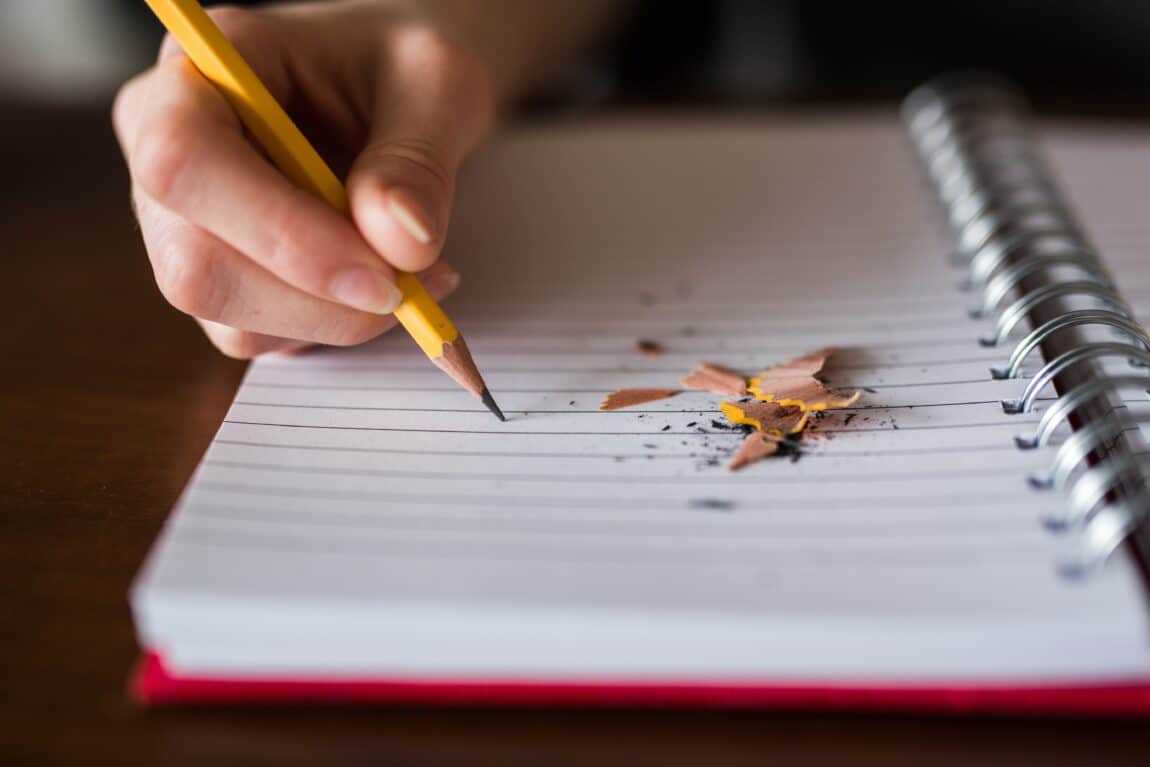
When it comes to the pencil, I would recommend a simple HB pencil or a mechanical pencil like the Staedtler Mars 780 Technical Mechanical Pencil
Just remember not to underestimate the value of the pencil!
Aside from the pencil, you will also need a ruler in order to create your calligraphy guidelines.
The best ruler for calligraphers is the rolling ruler.
The rolling ruler allows you to quickly draw parallel lines as well as other shapes with ease

Check out this quick video about the rolling ruler and all the different things it can do –
4. Various markers and ballpoint pens
Mostly used for creating Faux Calligraphy and other styles of modern calligraphy, these markers can indeed be a great addition to your lettering.
Adding effects, patterns, colors, and pretty much anything that comes to your mind, is one of the benefits when working with modern calligraphy.
5. Calligraphy paper
When it comes to paper, the choice can become overwhelming quite quickly.
These are the three brands of paper that I always recommend to beginners –
To learn more about paper, check out my calligraphy paper guide.
How to start with modern calligraphy – basic strokes
How to hold a brush pen?
First things first let’s just quickly cover this part because I often see beginners struggling with how to hold a brush correctly.
Different people like to hold the pen in different ways but the most important thing is the angle at which you hold it.
Check out the reference image below –
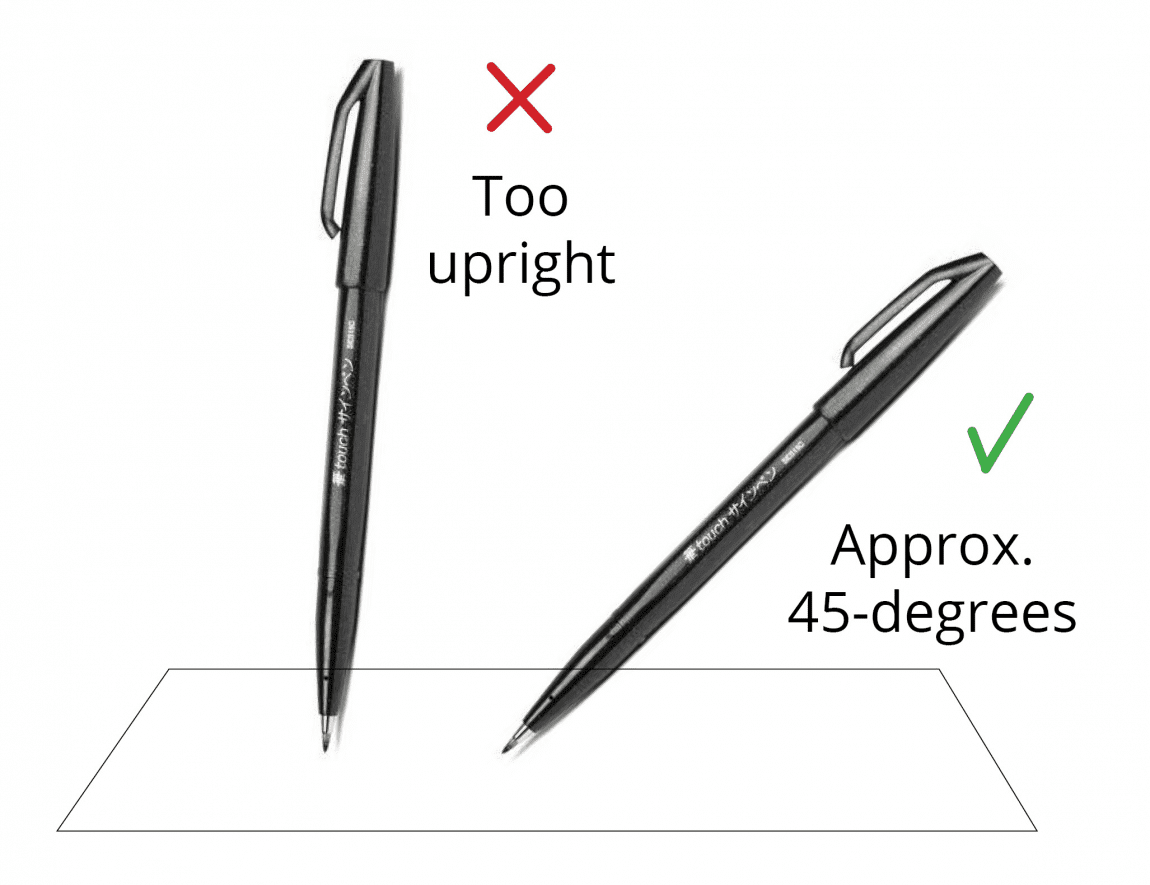
Holding the pen too upright will not give you the desired effect (thick and thin contrast) and it will also damage the tip of your pen.
That being said, the next important part is to know where to apply thin strokes and where to apply the thick strokes. (if you already know this feel free to skip to the next section)
The general rule is that your strokes going up are thin while the ones going down are thick.
The thick down strokes are created by applying pressure, while the upstrokes are done with the tip of the pen – without applying any pressure.
Check this image reference –
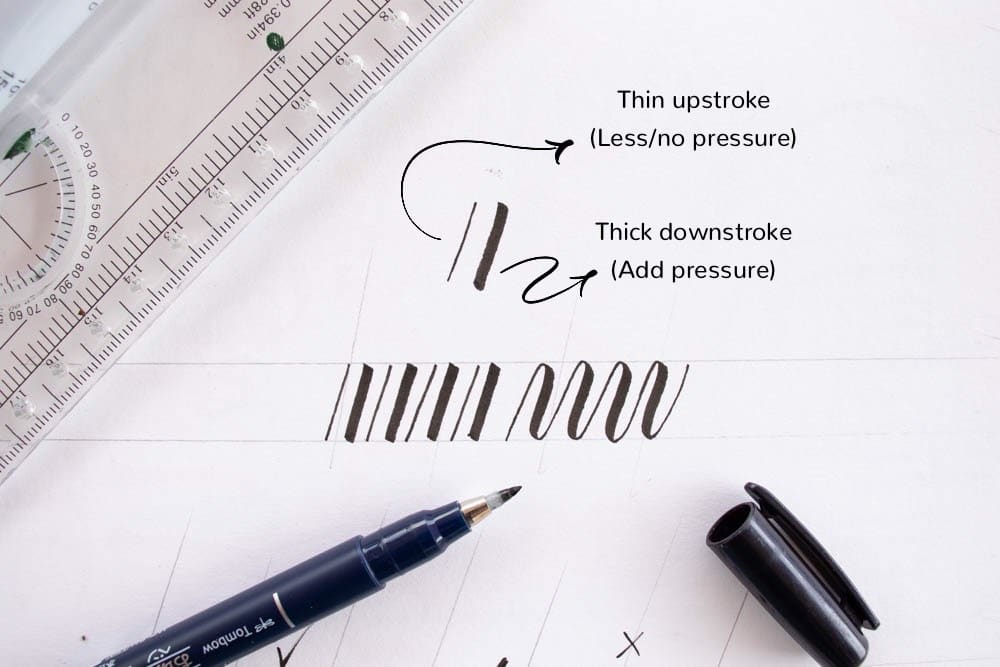
If you are a complete beginner, it is essential that you first get familiar with the brush pen and how to use it.
Before even thinking to start writing letters and words, try to get comfortable creating thin lines when going up and thick lines when going down.
This will help you to get to know the tool, and you will start developing a feeling for it in your hand –
something that is also known as muscle memory.
Stick to the end of this article to find out more about what muscle memory is.
The basic calligraphy strokes
Once you feel comfortable enough using the brush pen, we can move forward and start learning the basic calligraphy strokes.
In case you haven’t noticed, a lot of letters contain similar shapes.
There are 7 basic strokes, and by combing these basic strokes, we can create nearly any letter of the lowercase alphabet.
Easy right?
Here are the basic shapes I would like you to practice before you jump straight into the letters.
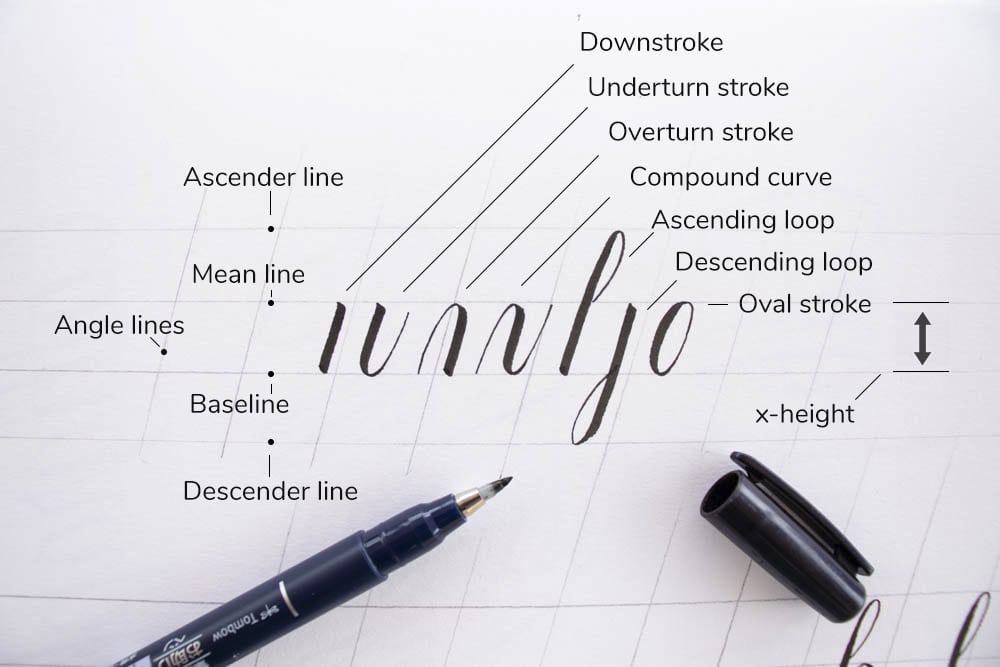
And here is a quick example of combining the different basic strokes in order to create letters and even words.

I created a whole separate tutorial that will teach you everything you need to know about the basic calligraphy strokes and how to use them.
In the video below, I demonstrate how you can use these basic strokes to create the whole lowercase alphabet.
I use different colors for each separate stroke so you can clearly see the distinction.
Once you understand the basic calligraphy strokes, you can also check out this tutorial, where I teach you how to write the whole lowercase alphabet step by step.
A few fundamental rules about modern calligraphy to keep in mind
I know that from a beginner’s perspective, this might already seem overwhelming, but there are just a couple more things that i must mention before we proceed (for your own good!)
There are a lot of things to talk about and explain, but it would be really hard to fit everything in a single tutorial.
Also, I promised at the beginning of the tutorial that I would try to keep things simple.
So the two basic and fundamental rules I want you to start implementing in your practice are Consistency and Spacing.
Let’s dive in!
1. Consistency
Keeping our letters consistent helps to increase the overall visual harmony. (something pleasing to the eye)
In order to keep your letters consistent, you MUST use calligraphy guidelines.
I see way too often beginners discrediting guidelines and simply trying to eyeball the heights, angles, etc.
When I talk about consistency in modern calligraphy, I don’t mean that you have to aim for perfection and mathematical precision.
As you can see in the example below, it has plenty of imperfections. However, the letters do follow the same height and angle.
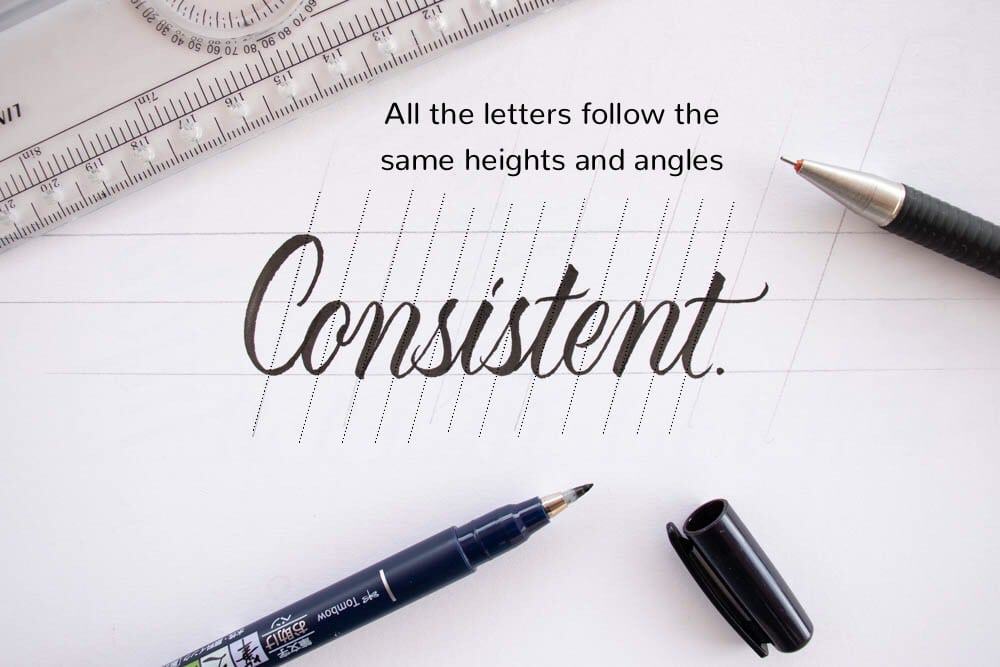
All you need to achieve more consistency in your letters is a pencil and a ruler.
Using the ruler and the pencil, create the baseline and the mean line (to create the x-height).
Add the ascender line, the descender line, and the slant lines that will determine the angle of your letters.
I often get the question –
What sizes should I use?
Considering we are talking about modern calligraphy here – you are free to determine the height, size, and angles of your letters.
Check out this example below –
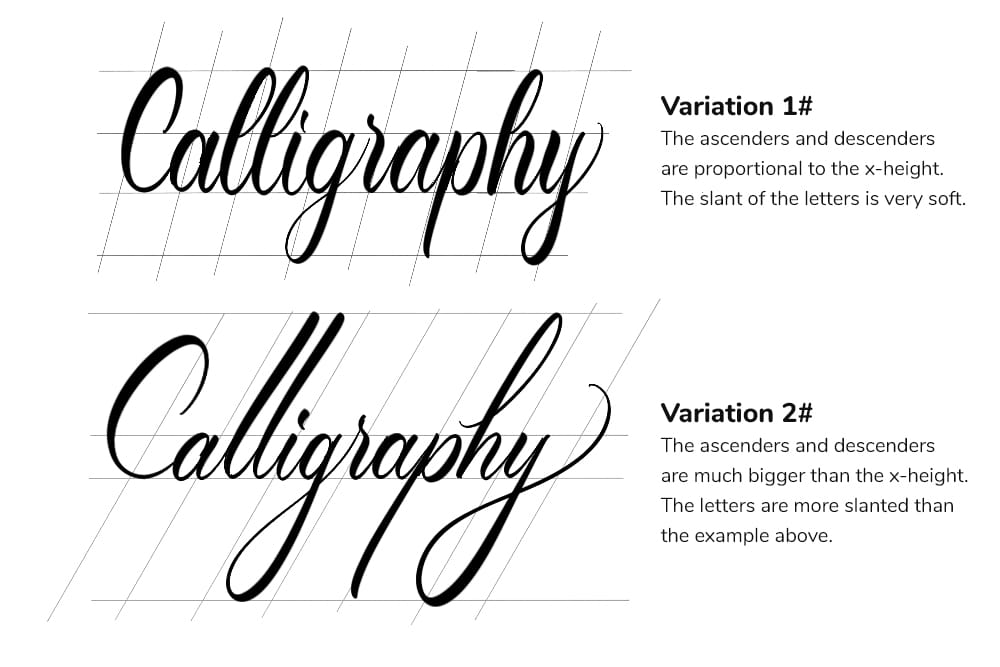
I cover all of this and more in my how to create calligraphy guidelines tutorial.
Avoid doing this –
Here is an example of what you should avoid doing.
This is what happens when you don’t use guidelines.
I’ve added the lines later in Photoshop to show you how inconsistent this actually is.
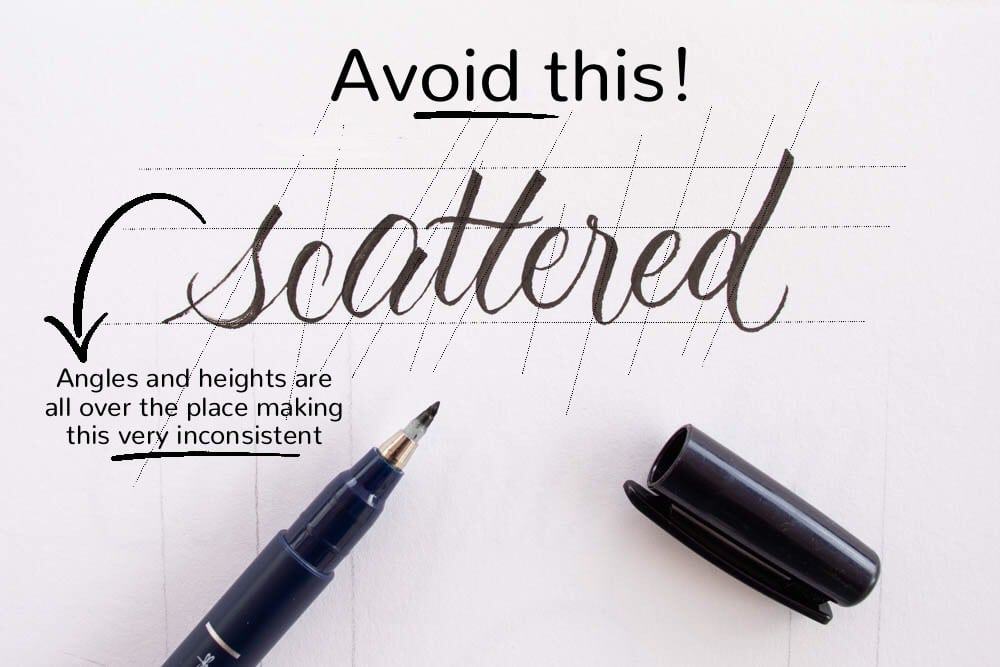
2. Spacing
Good spacing between the letters helps you to keep a high level of legibility.
If the letters are too squished together, that could have a negative impact on your calligraphy – of course, we want to avoid that.
In order to maintain good and consistent spacing, you need to go slower, lift your pen between each stroke, and also keep an eye on the space of the previous letter pair.
Again, this is something that will just improve with time and practice.

FREE worksheets – basic strokes + lowercase alphabet
As I mentioned previously, you probably managed to notice that some letters are similar to others, and the good news is that we can use this to our advantage!
To improve your practice efficiency, I’ve divided the letters into separate groups based on their similarities.
So, we have 5 different letter groups –
- Straight letters – i, l, t, f,
- Branching letters – n, m, h, b, p, k, r
- Reverse Branching letters – u, y, a, d, g, q
- Oval letters – o, c, e
- Diagonal letters – s, v, w, x, z
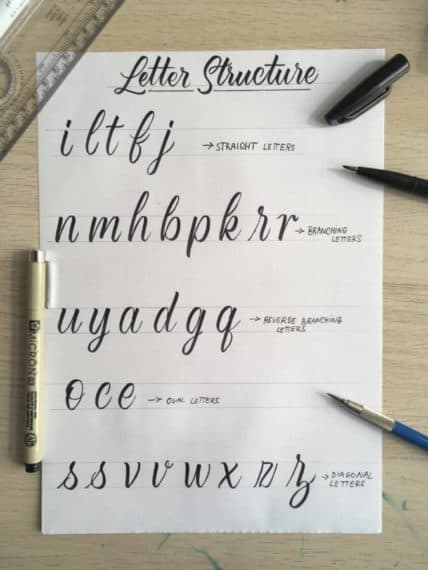
Be sure to check out the bonus section on how to practice effectively before you start using these sheets.
You can download 2 different types of practice sheets depending on the size of the brush pen you prefer to work with.
We have practice sheets for both smaller and bigger brush pens.
Big brush pens – Tombow Dual brush pen, Lyra, Artline Stix, Sharpie, etc.
Small brush pens – Tombow Fudenosuke, Pentel Fude Touch Sign pen, Zebra brush pen, etc.
Drop your email below, follow the instructions, and you will get instant access to these worksheets as well as other worksheets currently available in the Lettering Crate.
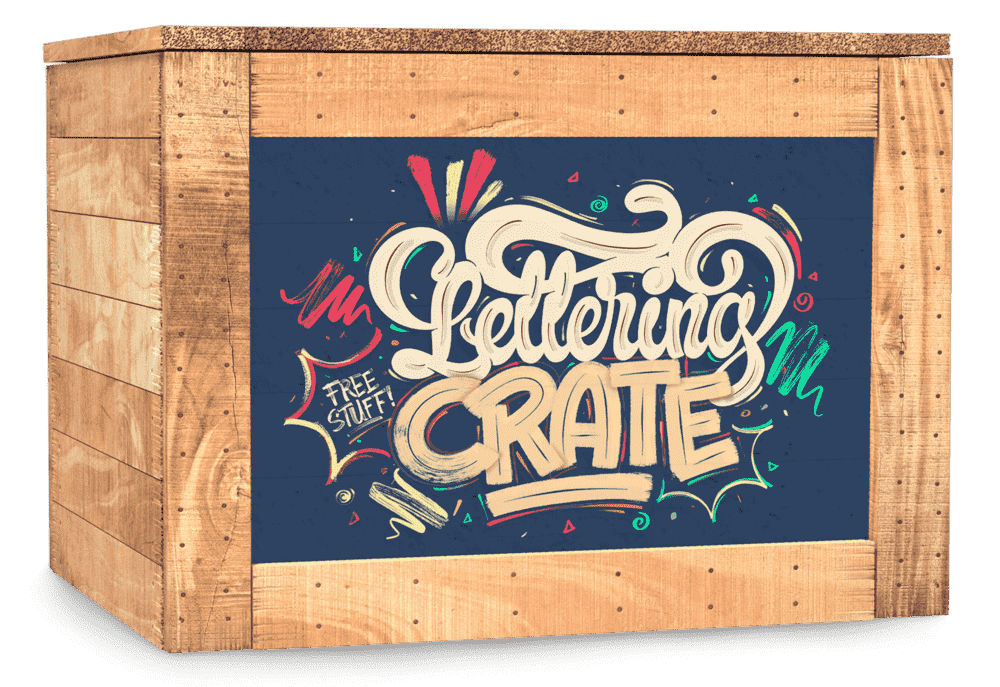
Stay updated with my tutorials and get instant access to the Lettering Crate –
A growing library of free lettering & calligraphy resources that includes –
Popular modern calligraphy techniques (step by step)
Once you feel confident with basic strokes, you can start experimenting with different styles.
In this section, I am going to guide you step-by-step on how you can create 3 different (popular) modern calligraphy styles.
1. Bounce lettering
Bounce lettering has become quite popular, and it can be seen all over the internet.
It is called bounce lettering because that’s exactly how it looks like – the letters bounce up and down!
This style is a perfect example of modern calligraphy since it defies the rules of traditional calligraphy.
What tools do you need for bounce lettering?
- Brush pen
- Pencil
- Ruler
- Paper
Let’s jump right into the step-by-step on how to do bounce lettering, so get your tools ready!

Step 1 –
draw some light guidelines using a ruler and a pencil.
We are going to draw the baseline, the mean line, as well as some lines for the angle of our letters (keeping up with consistency)
Feel free to determine the sizes by yourself – if you want the letters to be bigger or smaller, straight or slanted, that’s completely up to you.

Step 2 –
With your pencil, gently write the base of the word.
This step will only be necessary at the very beginning; once you have practiced a lot and you have finally developed a feeling for it, you won’t need to sketch out your word every time.
Here is the key to bounce lettering –
As mentioned earlier, bounce lettering is called that because the letters bounce up and down.
In order to achieve this, we are going to write every consecutive letter above and below the baseline.
Check out the image below –

Once you gain a bit more experience, you can play around and experiment with the bouncy pattern.
Step 3 –
Now that we have our word sketched out with the proper bouncy pattern, it’s time to go over it with our brush pen!
Remember – our up strokes are thin, while our down strokes are thick!

That’s it!
Great job, in case it didn’t turn out as good as you expected –
DO NOT WORRY!
Grab your tools and repeat the process again. Calligraphy is all about repetition and building muscle memory –
The more you do it, the better you become at it!
2. Distant lettering
Not really sure if there is a different name for this technique (if there is, be sure to drop a comment below)
I named it distant lettering since its main characteristic is that the letters have a large space between each other.
What do you need for distant lettering?
- Brush pen
- Pencil
- Ruler
- Paper
The process of this technique is fairly similar to the bounce lettering that we just did.
Step 1 –
This style has more of a ”flowy” feel to it. Therefore instead of drawing a straight grid, im just going to keep a hand-drawn underline, and with the ruler, I’ll make some straight-angle lines (keeping the slant consistent).

Step 2 –
Using your pencil start writing a rough sketch of your letters, only this time extending the ending strokes of the letters.
Like this –

Step 3 –
Try to keep a consistent amount of spacing between each letter – it doesn’t need to be perfect, just don’t make it too obvious!
Once you are done writing with your pencil, it’s time to grab your brush pen and go over the pencil sketch.

Once again, if you are not satisfied with the result, simply start over and then do it again and again and again… you get the point 😀
3. Faux calligraphy
Faux or fake calligraphy is awesome because it can be done with any kind of writing tool!
On top of that, it’s very easy to learn.
Due to its popularity, I decided to create a separate tutorial for faux calligraphy where I dive into this topic more in-depth.
We also included some free practice sheets, and if you want to learn more about faux calligraphy, I highly recommend you check out this tutorial.
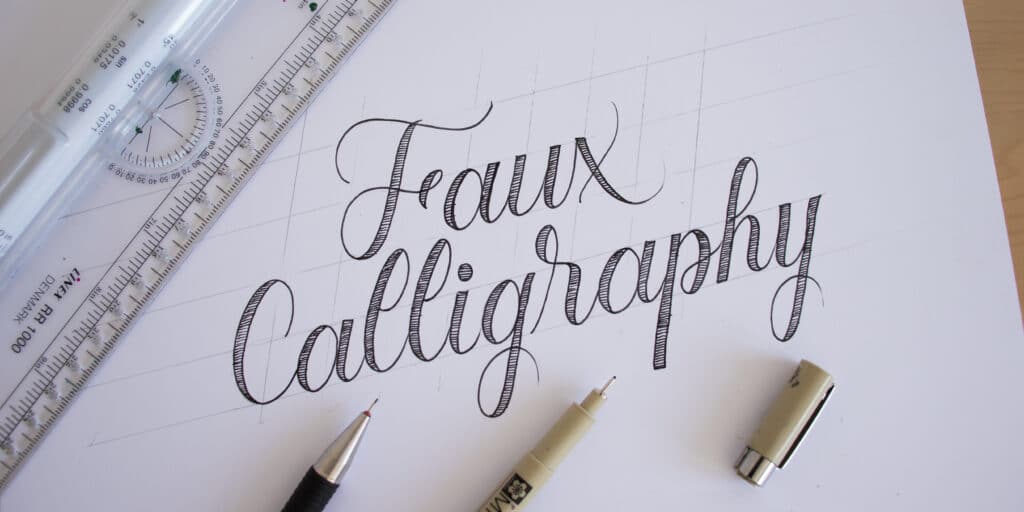
(BONUS) 4. Creating your own unique style
One of the best parts about modern calligraphy is that you can deviate and create something unique.
Try to create something that you like simply by following your own intuition.
Just keep in mind the rules that we talked about (consistency, balance, and spacing), and keep exploring your creativity.
A golden tip! –
First, you need to relax! if you are angry, frustrated, or even hungry, you will struggle with your creative flow. The second thing that will really spark your creativity is to listen to some good music! (the one that you like, obviously) – I know that this may sound weird, but it really helps with creativity!
You can also find inspiration from other artists and create your own variations of a certain style.
Who knows, maybe YOU will create a new style that will become a new trend in the online calligraphy community 🙂
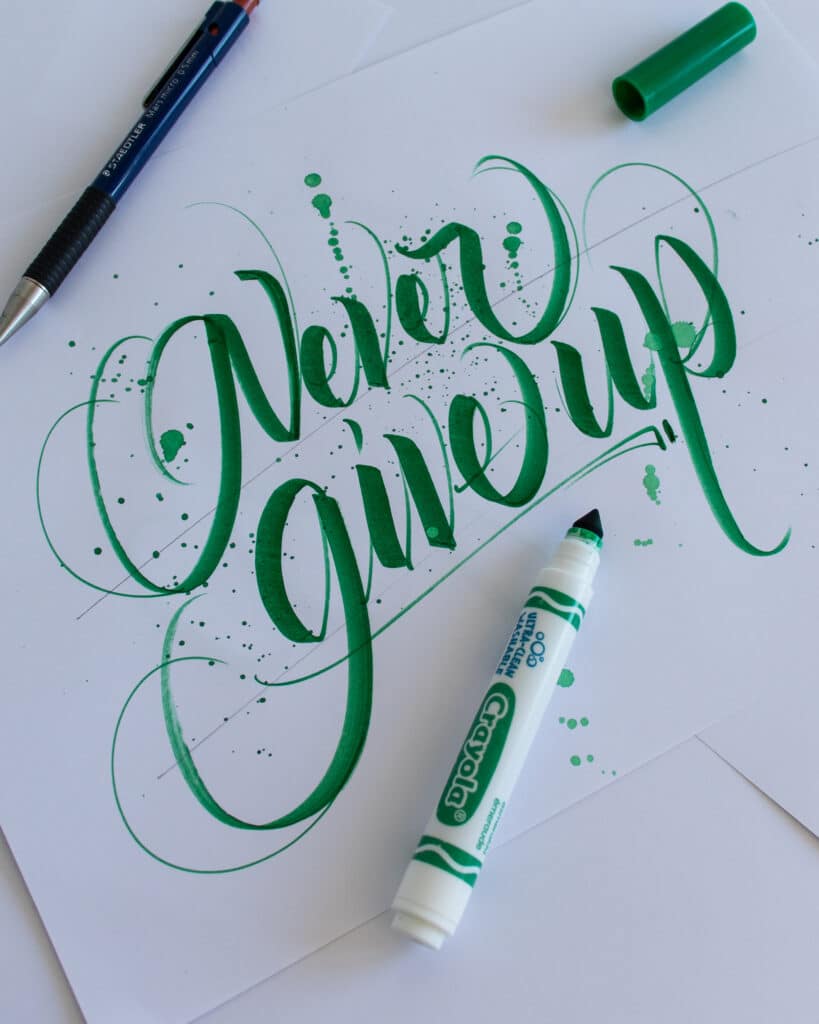
BONUS – How to effectively practice modern calligraphy
Before you print the practice sheets or you just start practicing, I wanted to share a couple of tips that could help you with your practice routine.
Practice is the defining element for progress, but the way you practice makes all the difference.
With deliberate practice, you can achieve more in less time, and let’s be honest – who wouldn’t want that?
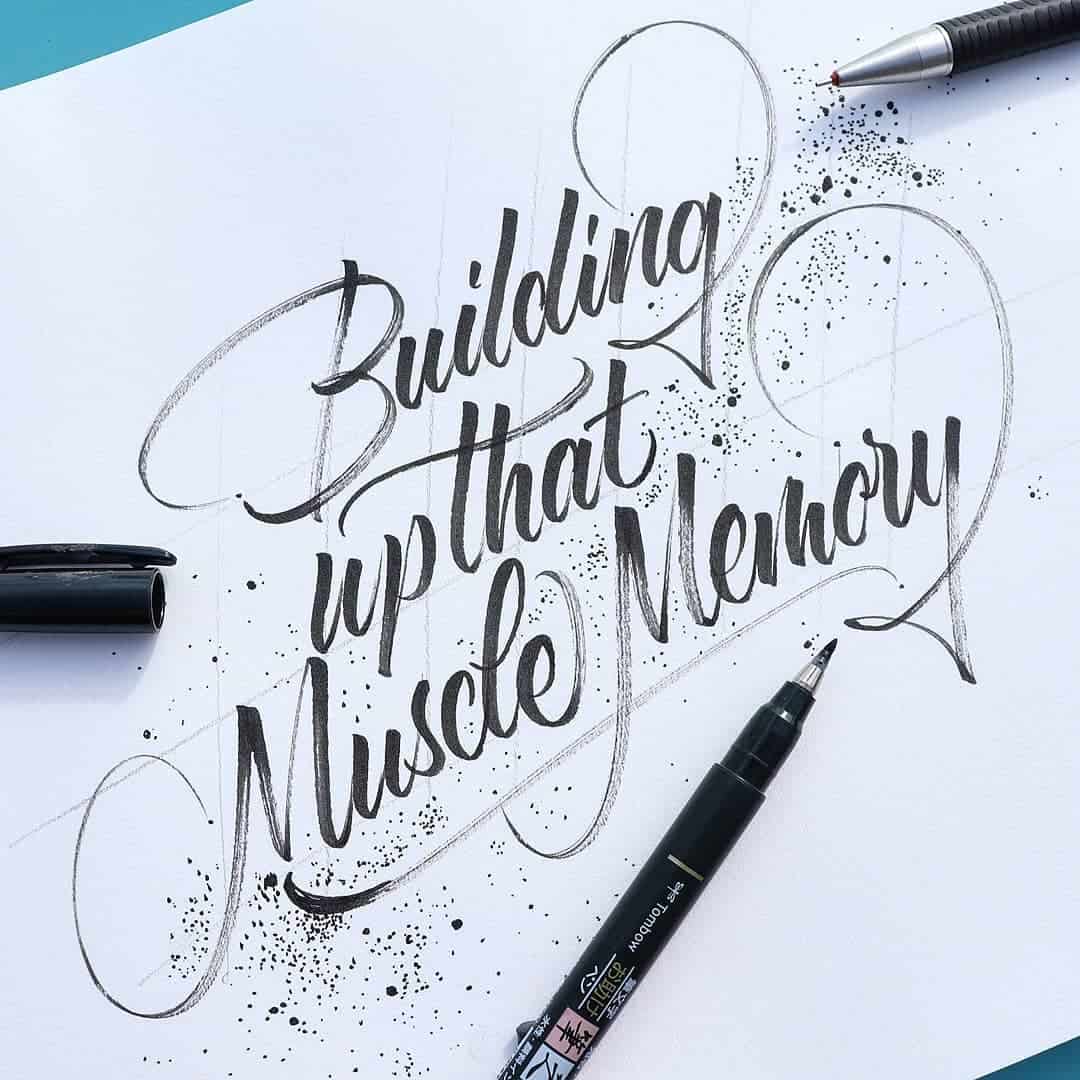
What happens after a lot of practice?
You will quickly notice that the more your practice the more confident you feel with your strokes.
As I mentioned earlier, you start to build something called muscle memory.
For those who are not familiar with the term, here is a quick definition –
Muscle memory is a form of procedural memory that involves consolidating a specific motor task into memory through repetition, which has been used synonymously with motor learning. When a movement is repeated over time, a long-term muscle memory is created for that task, eventually allowing it to be performed without conscious effort. This process decreases the need for attention and creates maximum efficiency within the motor and memory systems.
If you are interested in learning more about muscle memory, I HIGHLY recommend watching this short video below.
It’s one of my favorite videos on YouTube and it comprehensively explains what muscle memory is and how it works.
Imagine building a house.
This is an analogy that I often use to describe what the learning process should look like.
When building a house, you will start by laying down your foundation.
Once you have that, you can start building your walls and your roof.
Then you can make your windows and the doors, and finally, you can paint them and decorate them.
With calligraphy (or pretty much any other skill), the process is fairly similar.
It makes no sense to learn and practice flourishing if you still don’t have the basics down.
Working with multiple words and layouts will be quite difficult if you are still struggling with single words.
What I’m trying to say here is – take it slow and build your skills gradually!
I understand that when you scroll on Instagram and you see all that amazing work, you just want to create something like that.
I also understand that doing the basic stuff seems pretty boring.
However, believe me, by gradually building up your skills, you will see more progress in less time!
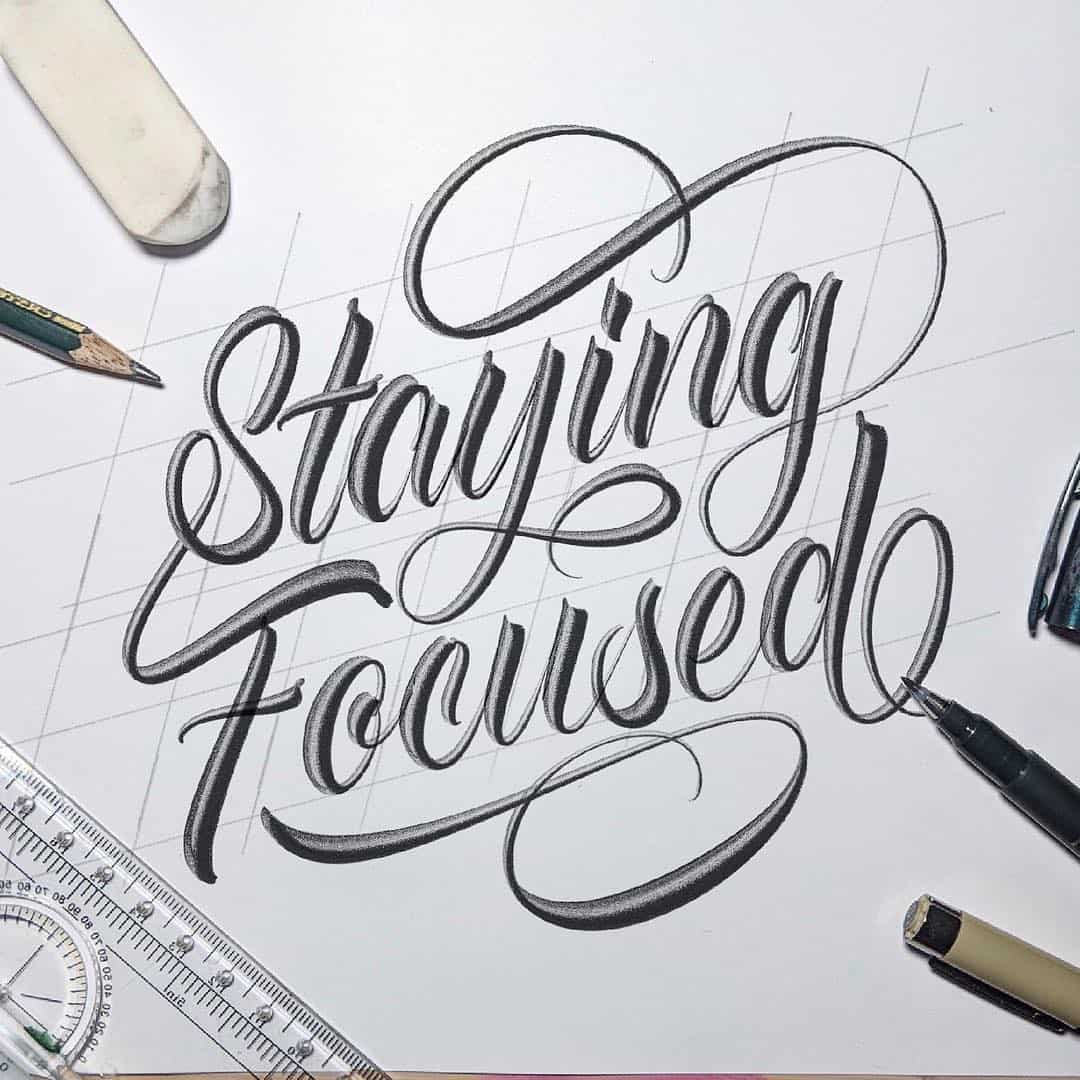
Here are a couple of actionable tips on how to practice more effectively –
- Practice daily! – I know that many of you have tight schedules and struggle to find time for practice. However, it’s much better to practice daily for even 15-20 minutes than twice a week for two hours (consistency over intensity).
- Warm-up drills – before you jump straight to writing your words, warm up your hand muscles by filling in a sheet of the basic drills, for example (included in the freebie). It will take you only a few minutes and make a difference!
- Proper posture and placement of the tools – you practice calligraphy by sitting at a desk, period! I’ve seen people practicing while sitting on the couch, lying in their beds, etc. If you plan to practice like that, don’t expect much progress. Check out these YouTube videos from Paul, where he explains it further in-depth.
- Use guidelines! – as mentioned earlier, guidelines will help keep your letters consistent.
- Stick to the basics – avoid multiple words (layouts) and any excessive effects. For the first weeks, focus on the basic strokes and incorporate them properly to create single words. Focus on keeping your letters consistent – build your foundation first!
Final thoughts on modern calligraphy
I know that this is a lot of new information if you are just getting started, but honestly, the best thing to do is – just start!
Firsthand experience will teach you more than anything else.
Are you looking to get some constructive feedback on your work?
Do you have a specific question, and you struggle to find an answer online?
Maybe you just want to nerd out with fellow calligraphers.
If so, check out and join our official Facebook group!
The official Lettering Daily Facebook group is a place where you can –
- Share your work
- Get constructive feedback
- Network with fellow lettering & calligraphy artists
- Ask specific questions about lettering & calligraphy
- Much more!
Oh, and as a final note, in case you would like to learn more about other calligraphy styles, be sure to check out my article on the 10 calligraphy styles for beginners.
Thank you for joining for another tutorial, and until the next time –
Stay AWESOME!!
Pin me!
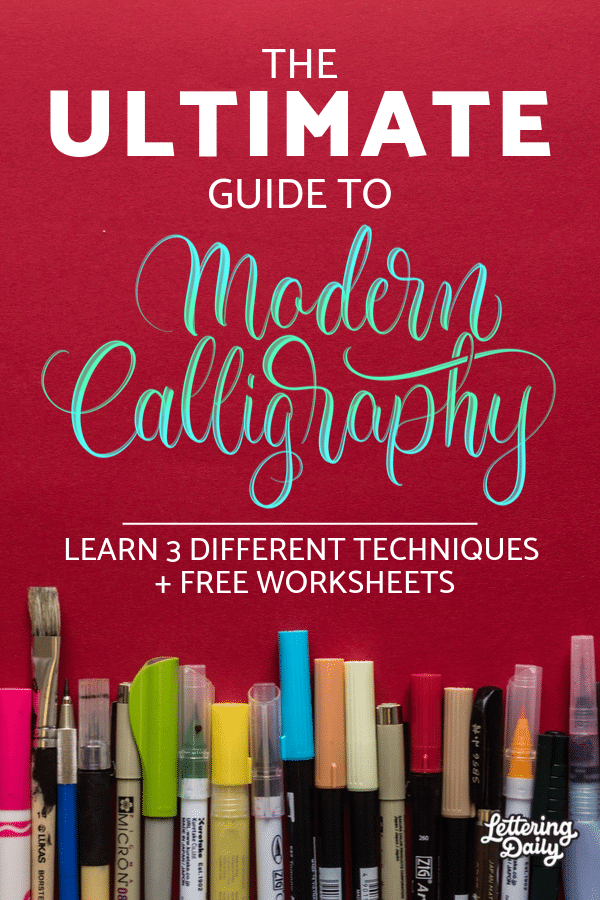
About the author

Meet Max Juric, a dedicated calligraphy and hand lettering artist with over a decade of experience. His artistic journey is deeply rooted in a passion for lettering and a commitment to continuous growth. Max’s extensive experience spans several years as a full-time lettering artist, collaborating with clients from around the globe. Over the past five years, Max has actively shared his expertise, reaching more than 100,000 individuals monthly through a rich array of educational resources. These resources include tutorials, interviews, articles, and podcasts. Max’s practical experience, combined with his unwavering dedication to his craft, sets him apart in the realm of hand lettering and calligraphy. With an educational platform offering over 100 long-form resources, Max aims to guide artists and enthusiasts in enhancing their hand lettering and calligraphy skills. Welcome to Lettering Daily, where artistic expression and learning beautifully intersect.

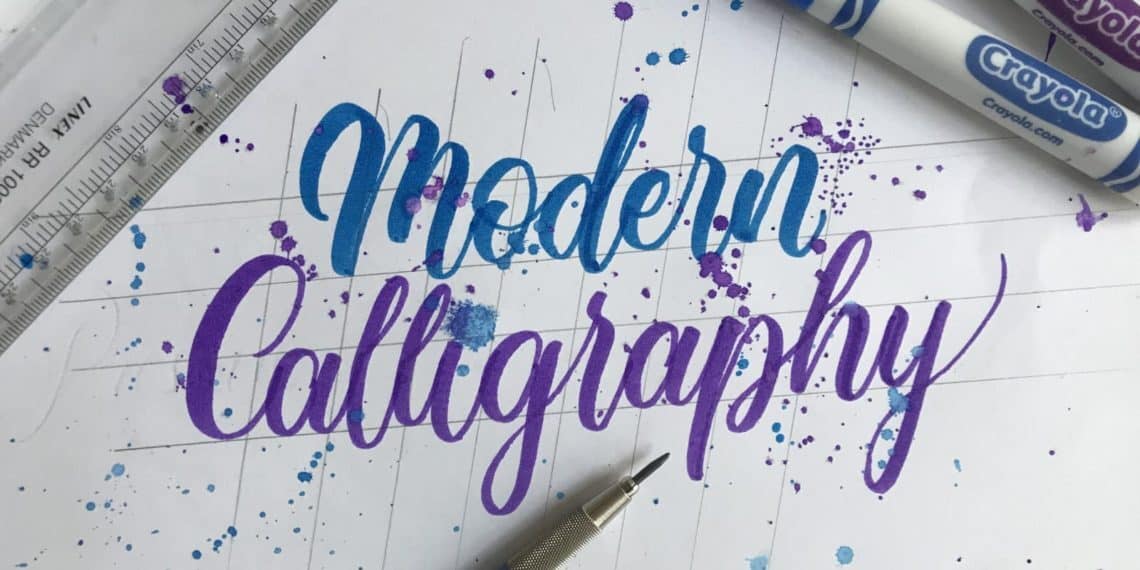
Does anyone know the source or the artist on that pink flourishing work from the article photo? I don’t find that photo anywhere in the actual article or worksheets. Thanks!
Which pink flourishing?
I like your suggestion to much But there are some things that neither avalibale in our area I use only 605 marker Hashim from Pakistan
How can I get question paper for calligraphy
Can you rephrase the question? Im not sure I understand.
Thank you so much for sharing a very details tutorial. I like learn more about calligraphy. May I have you to share the lettering practice sheets. Thank you.
The worksheets are all in the Lettering Crate 🙂 Thank you for the kind comment.
Hello there! This blog post could not be written any better!
Looking through this article reminds me of my previous roommate!
He constantly kept talking about this. I most certainly will send this information to him.
Fairly certain he’ll have a very good read. Thanks for sharing!
For a second, I thought you were my ex-roommate 😀 hahah Thanks!
Hai 😊i already given my email id but i didn’t receive the practice sheet can you please help with practice sheets
Shoot me an email with you address and ill fix it right away.
Lovely tutorial. I think it is one of the best explanations for any tutorial for that matter.
Thanks!
Thank you so much! Im soon updating this whole post, and if you have any ideas, wishes and suggestions, please make sure to let me know.
I’ve stumbled across this post while researching different calligraphy styles. I’m thrilled. Everything is so clearly explained. Now I understand why modern calligraphy differs from traditonal. This is definitely a post I’ll keep refering to. Thank you so much. I can’t wait to start practicing drills and finally enjoy calligraphy for what it is. Thank you.
Thank you so much for the kind words 🙂 Makes me really happy to hear that.
Thanks a lot for this, now I can improve my callig <3
cheers! 🙂
Do you have any uppercase worksheets for Modern Calligraphy? I’ve gotten a lot out of the lowercase worksheets but I can’t figure out how to do the uppercase letters nicely! Thanks for this great resource 🙂
Hey Nora, no unfortunately I don’t. However, I’ll make sure to include them in the next update 🙂
I can’t take part in the discussion right now – I’m very busy. But I’ll be free – I will definitely write what I think on this issue.
On what issue?
Hi Lettering-daily team, just discover your website looking for inspiration to our spanish portal and I found one of the best Lettering sources of true, a great quality and perfect content for benginers and experts; I can’t stop reading your site ¡¡¡¡
I’m very happy, thanks a lot to sharing with us ¡¡¡
a big hug from Barcelona rockie lettering school ^^
Hi Lettering-daily team, just discover your website looking for inspiration to our spanish portal and I found one of the best Lettering sources of true, a great quality and perfect content for benginers and experts; I can’t stop reading your site ¡¡¡¡
I’m very happy, thanks a lot to sharing with us ¡¡¡
a big hug from Barcelona rockie lettering school ^^
https://lettering-barcelona.com
Thank you, Mireia! I really appreciate the kind words, and I’m happy to hear that you enjoy the content from my website 🙂
Thank you for the very useful and well structured content on calligraphy . I am a beginner , and after reading this I am so much motivated to keep on practicing . Thank you n God bless youuu.
Im really happy to hear that. Thank you for the super kind comment! 🙂
Thanks for the tutorial. I really appreciate
Please I’ll need the worksheets.
Thanks for the kind words! You can find all the worksheets inside the Lettering Crate 🙂
OMG Thank you sooooo much! I have tried to write this on my own, but it just looked crooked and the letters were uneven. After practicing like this for just a week, I feel like I made a huge improvement!
WOW! Love reading comments like these. Thank you so much for the kind words, Charis. Im glad to hear that 🙂
Hi Laura,
This is so helpful, thanks for the info. I’m a wedding celebrant and want to be able to do modern calligraphy on peoples wedding certificates.
Could you please email me your practice sheets?
Thanks in advance
Renee <3
info@reneethecelebrant.com.au
Check the lettering Crate for the practice sheets and other Goodies
– Kyle
Thank you, Kyle! 🙂
veery nice introduction to modern calligraphy! thank you for sharing it! I’m gonna check out other articles as well!
Thank you, Paulina! It really means a lot! Let me know if there are things you are struggling with. Those could be extremely helpful for upcoming updates! 🙂
It’s hard to say
Calligraphy is my passion. I have done many worksheets for my college and some for my work.
I have to admit it. This is so clearly explained. What if I want to collaborate with you and share some of my works, how to approach you?
Thank you for your kind words. I have created a Facebook group specifically with this in mind. Be sure to check it out, over there you can share your work, ask questions, and meet other fellow artists 🙂
I just found your website, I love it your content is great, the articles are easy to read and understand with the video and the links. I love it thqnk you again
Thank you so much, Linda, it really means a lot 🙂
Incredible ( you are doing good job)
?
The tutorial is show. It’s estimulate to practice. Thanks
hahah thank you so much! 🙂
Great tutorial. How did you get the splatter look? Did I miss it? Thanks.
Oh, no I didn’t explain that part. I’ll make a note to include it in the next update. But basically, you just dip a brush in a bit of ink and using your finger you just splatter a bit of ink around it 😀
This is an incredibly useful tutorial. I am in awe.
Thank you very much for the kind comment! I am glad to hear that 🙂
Wow! Your tutorial just broke down calligraphy into pieces for easy understanding. Now, I fully understand where to start from. I’m gonna start practising.
Super happy to hear that! 🙂
Very useful ?
Yep.
This was so helpful & encouraging. I actually printed the practice sheets & have been using the guidelines just a day or so and they’re helping me more than I believed they would. Thank you so much.
Reading comments like these make me so freaking happy! Keep working on it, and if you ever need any help with your practice – just let me know 🙂
Frankly,Mr Max, this is soo…mind blowing and well explained. Thank you for your shared knowledge and encouraging words, I feel like an expert already when the reverse is the case ?. Anticipating for more tutorials in future ?.
Yaay! 😀 Thank you, Ifenna! I am truly happy to hear that this was helpful for you. And don’t worry, new content is always coming 🙂
This was a really informative and and somewhat detailed article. I really appreciate the efforts you have put to spread skill and knowledge. Would be more than happy to receive worksheets. I am just starting. Budget constraints have made me start with a pencil. Will buy myself a calligraphy kit for my birthday. I am really excited to start and develop! ??
Thank you Shiny for the kind words! When you say ”somewhat” detailed article, what do you mean exactly? Do you have any constructive feedback on how to make it better? I would really appreciate it 🙂 Starting with a pencil is a great idea! Cheap and effective 🙂
Cheers! 🙂
Thank you ! I’ve wanted to do calligraphy for many years. You have provided the best instructions I’ve seen to date. I am so excited to make this happen! During these stressful times, calligraphy has provided a calm escape! Sincere thanks!
Thank you, Laura! I am really happy to hear that. I appreciate the kind words 🙂
After reading a good number of other good resources and having been practicing for a few days now, I find that yours summarizes, explains and equips me the best for success. Thanks so much for this and your Facebook group.
You have no idea how happy I am to read this! Thank you! I’ve put a lot of effort into this and I constantly try to make it better. If you ever have some suggestions, ideas or constructive feedback, please let me know! Cheers! 🙂
Hey…..this was awesome!As I had already completed the beginner’s course,I was searching for something more advanced.Here,I found exactly what I was looking for…thank you so much!
Thank you, Riya super happy to hear this! 🙂
Hey….this was of great help to me!As I had already completed the basic course,I was looking for something more advanced.Here,I found exactly what I wanted…thank you so much for the help!
please send me the free practice sheets you mentioned. thanks.
Hello Glenda, the practice sheets are to be found in the Lettering Crate, and in order to get access to them you need to sign up to the newsletter. Let me know if you need help with that.
This is a very good tutorial. I would love to receive the download-able practice sheets, especially the Faux Calligraphy sheets. Thank you.
Hey Trudy, all the sheets are available inside the Lettering Crate. Just sign up for the newsletter and you will get instant access to it 🙂
thanks for tips i got as a beginner,please i would need some practicable sheets yo work on ,thanks
Hey Pat, absolutely! You just need to sign up for the newsletter in order to access the Lettering Crate. Let me know if you need help with that. But basically you have a sign up form in every article of the website.
Thank you. Thank you. Exactly what I was looking for.
You are welcome, Elinor 🙂
Thank you for the really good info and explanation. Now let’s run
Thank you for the kind comment 🙂
Hi,your article is awesome! You have made it very clear and interesting in a sorted out,step by step manner.I am totally motivated and want to try it out today itself??
Hehe, thank you, Tanya! Happy to hear that! Cheers 🙂
I would like to purchase the rolling ruler featured in the video, but the site rollnruler.mov seems to have some problems, at least from the UK. Any suggestions?
Hey Jim, thank you for your comment. If you just scroll up where i mention the rolling ruler, you will see that there is a link. Just hit the link and you will be redirected to Amazon.
Thank you for talking about how when you work with a dip pen, you need to hold it at an angle that will work better and that takes a little bit of time to learn. I really want to become better at calligraphy, and I love crafting and making cute signs and things. I should look into purchasing all these materials to make sure I will be more successful in my attempts.
Thank you for your comment, Fay. Please let me know if you need any help or if you have any questions 🙂
Thank you very helpful
You are super welcome! 🙂
Thank you for your help
You are welcome! It’s a pleasure 🙂
Hi. Thanks a lot for this really clear guide for lettering!
I would like to receive the practice worksheets if you do not mind.
Sincerely Yours
M.K. Chiani
Thank you for your comment! In order to get the practice sheets, you need to sign up for the Lettering Crate. Once you do that you will have full access to all the freebies that we offer on the website 🙂
Thanks for this clear explanation of modern techniques!
You are very welcome Chris!
thank you!
You are super welcome!
Great article! What is the font called in the practice sheets?
Thank you Eric! It’s not a font. Fonts are what computers use. This is a modern adaptation of the Copperplate script – that’s really the closest thing I could call it.
Thanks a lot for this really clear guide for lettering for starters!
I would like to receive the practice worksheets if you do not mind.
Thanks again,
Silvina
Thank you, Silvina!
Be sure to join the mailing list in order to get access to the Lettering Crate! 🙂
Truly amazing. I am a beginner and I thought that calligraphy might be that easy, but actually,,,,, IT’S NOT ?
when I looked upon your tutorial I think it act like a teacher!!!
Thank you LETTERING DAILY for such a innovative and easyyyy ways of modern calligraphy. I loved the fact that you mentioned the requirements with respective videos and images.
(☺ —— ?)
You are super welcome! Happy you found it useful 🙂
Thank you for providing such clear instructions in your tutorials. I just began practicing calligraphy and I have found it to be a lot more difficult than I ever thought it would be! But I love the challenge! I’m grateful that you are posting some very helpful information!
Sincerely,
Linda
Thank you! The beginnings are always hard, just stick to it and you will see progress 🙂
Your tutorials are so clear–thank you! I’m a beginner and a little intimidated! I am having trouble finding the practice sheets, for this one and the faux caligraphy lesson. I did enter my email (again) where indicated, but have not received an email with the practice sheets. Have I loverlooked something? What do I need to do to get them?
Hey Kate, thank you so much for the kind words. We are really happy to hear that you found the tutorials to be helpful. Once you enter your email, you should receive a confirmation email (to confirm the subscription) and then you get an email that contains the link and the password to our Lettering Vault (resource library), where all of the free downloadable content is located. This second welcome email, sometimes tends to end up in the spam folder – have you checked there? In case you are unable to find it, please reach out via email and I will personally send you over the access to our Lettering Vault 🙂
Cheers!
The tutorial is amazing….I am a beginner and did not know where to start but now everything seems so crystal clear…thanks
You are very welcome 🙂 Now it’s all about consistent practice!
Thats good. Would like to learn more…
Modern calligraphy that is done well and is legible does follow rules. You MUST learn the rules to break the rules!
Ok. I have to admit it. Your tutorials actually inspire to practice. ☺️?. And I mean print out the practice sheets and use guidelines type of practice. You make everything straight forward and easy to understand. ?
hahah! Thank you Stephanie 🙂 Im really glad it has that effect on you – that was exactly the point!
Keep practicing and be sure to share some of your work on our forum. Once a week we share our favorites on our Instagram feed 🙂
I like learn more about calligraphy if you more info or if you have lettering practice sheet. Suppose you have more lettering style please show me the print out lettering sheet thank yo7
Thank you Lucy,
You can find the practice sheets in this tutorial – they should be somewhere in the middle 🙂